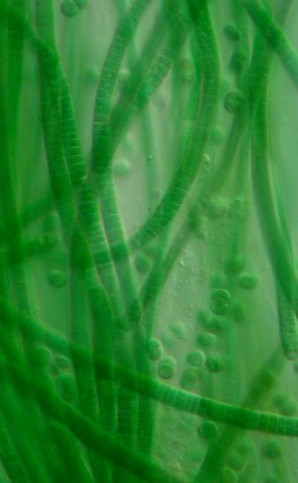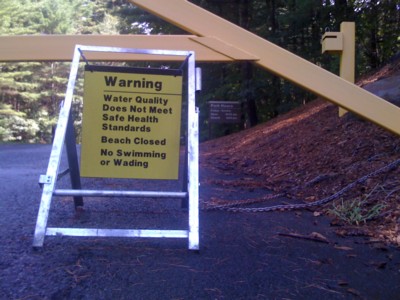Lake Siog and the cyanobacteria.
The Holland Blog reported about the closing of Lake Siog (Holland Pond) for swimming and wading last Tuesday, July 28, 2009.What seemed to be just an event triggered by heavy rain and the increase of E-Coli (Escherichia coli) bacteria count consistent with such events in populated areas is much more serious. The bacteria causing concern is more dangerous than the feared E-Coli bacteria; the bacteria forcing the closure of lake Siog are cyanobacteria. Cyanobacteria are also known under the term “Blue-green algae.”
Taxonomy is difficult; bacteria by definition are single cell organisms. In that sense it is incorrect to call cyanobacteria blue-green algae. However, if the cyanobacteria are at dangerous levels, biologists call it a blue-green algae bloom.

Lake Siog experiences this unsafe algae bloom. The concentration of the cyanobacteria can reach dangerous levels if conditions are “ideal;” an abundant nutritional source combined with adequate sunlight, along with water and the right temperature range is the combination needed for this dangerous toxin to flourish.
What makes these cyanobacteria so dangerous is the fact that they release toxins when they die. The color of dead bacteria colonies is cyan in color, hence the name.
The released toxins attack the nervous system and the liver in particular of humans. Children are at higher risk due to their smaller body weight. Animals, including pets, fish, blue heron and other birds, and any other wildlife that is drinking the water is also ingesting the toxin and would also be at risk.
Boiling the water does kill the bacteria; however, the toxins are released by the dying cyanobacteria and boiled water is not less toxic than the un-boiled!
The question is, how can the growth of these dangerous bacteria be prevented?
Cyanobacteria rely upon nitrogen and phosphorous for their nutrients, much of which enters Hamilton Reservoir through runoff from the many fertilized lawns as well as septic systems. It is imperative to reduce the supply of these nutrients to keep lake Siog, which is downstream from Hamilton Reservoir, healthy.
What is little known, is the fact that the many boats operating on Hamilton Reservoir during the summer are part of the problem.

David N. Nedohin and P. Elefsiniotis published a study with the title, “The effects of motor boats on water quality in shallow lakes.”
The study was performed to determine if motor boats could accelerate the rate at which eutrophication occurs in shallow lakes.
Two lakes were examined and tested for pH, turbidity, and phosphorous concentrations: One with motor boat activity and one without. Results indicate that motor boat activity creates enough disturbance on the bottom sediment to release the stored phosphorous into the overlying water.
The authors indicate that a 10hp motor boat mixes water down to a depth of 6 feet, increasing to 15 feet for a 50 hp motor. Certain water ski boats are significantly more powerful than this, reaching 300 hp. Hamilton Reservoir is a shallow lake, and very few spots are deeper than 15 feet.
In general, the phosphorus entering a lake will accumulate in the top layers of the lake sediments. This takes place particularly through the spring and summer as a result of stratification and of assimilation by plants and algae which subsequently die and sink to the lake bottom. Mixing by motor boats will re-circulate this phosphorus containing sediment back into the water, increasing phosphorus levels and enabling algae growth. Motor boat mixing and algal growth both increase turbidity.
The study was published in,
Toxicological & Environmental Chemistry, 1029-0486, Volume 61, Issue 1, 1997, Pages 127 — 133.
To read a summary of Impacts of motor boats on water quality,
click here!
Cyanobacteria are one of the earliest types of bacteria and were around long before algae. Fossil evidence indicates that these bacteria existed approximately 3.3 billion years ago and were the first oxygen producing evolving phototropic organisms. They are responsible for the initial conversion of the earth’s atmosphere from an anoxic (state without oxygen) to an oxic (with oxygen) state. Being the first to carry out oxygenic photosynthesis, they were able to convert carbon dioxide into oxygen playing a major role in oxygenating the atmosphere. To read a report about the cyanobacteria published in the Magazin on European Research, click here!
Nancy McNally form the US Army Corps of Engineers who is in charge of taking the water samples from lake Siog witnessed a strong unexplainable increase of dead cyanobacteria in the first week of July. By coincident Nancy learned through reading the piece
“Notification of Aquatic Treatment Hamilton Reservoir”
on the Holland Blog of the yearly treatment with chemicals by the firm Aquatic Control Technology, Inc. on June 23.
According to Nancy, the spike in dying Cyanobacteria could be the result of the chemicals washed into lake Siog which is downstream from Hamilton Reservoir. The fact that dead cyanobacteria are no longer capable of multiplying themselves is a positive; the abrupt death of too many bacteria is detrimental as the concentration of the released toxins is a danger to humans, pets and wildlife.
 According to Nancy McNally it is quite possible that lake Siog will have to remain closed to the public for the rest of the season.
According to Nancy McNally it is quite possible that lake Siog will have to remain closed to the public for the rest of the season.
Click here to read information about the cyanobacteria posted on the New Hampshire Department of Environmental Services webpage.
August 6, 2009, Peter Frei